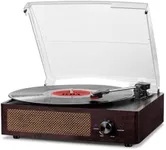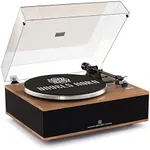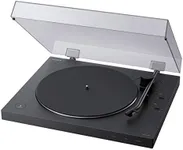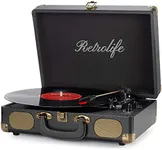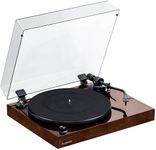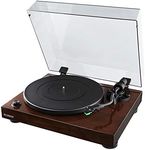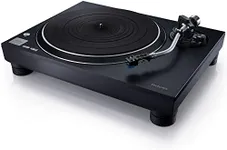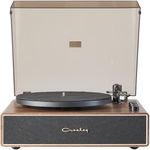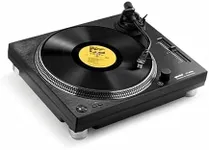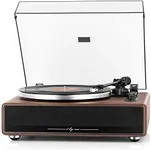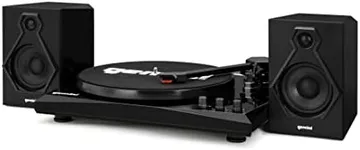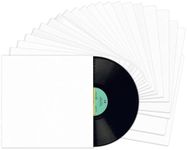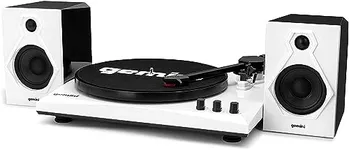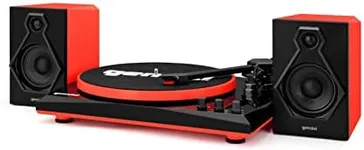Buying Guide for the Best Turntable Record Players
Choosing the right turntable record player can be a delightful journey into the world of vinyl music. Whether you're a seasoned audiophile or a newcomer to the vinyl scene, understanding the key specifications will help you make an informed decision. The right turntable for you will depend on your listening preferences, the quality of your audio system, and how you plan to use the turntable. Here are the key specs to consider when selecting a turntable record player.Drive TypeThe drive type refers to how the turntable's platter is powered. There are two main types: belt-drive and direct-drive. Belt-drive turntables use an elastic belt to spin the platter, which helps reduce motor noise and vibration, making them ideal for home listening. Direct-drive turntables have the motor directly connected to the platter, providing more consistent speed and torque, which is preferred by DJs for scratching and mixing. Choose a belt-drive if you prioritize sound quality and a direct-drive if you need durability and precision for DJing.
Platter MaterialThe platter is the part of the turntable that the record sits on. Common materials include plastic, aluminum, and acrylic. Plastic platters are lightweight and affordable but may not provide the best sound quality. Aluminum platters are more durable and offer better sound isolation. Acrylic platters are considered high-end, providing excellent sound quality and reducing unwanted vibrations. If you're looking for a balance between cost and performance, aluminum is a good choice. For the best sound quality, consider an acrylic platter.
Cartridge TypeThe cartridge is the component that holds the stylus (needle) and converts the grooves in the record into an audio signal. There are two main types: moving magnet (MM) and moving coil (MC). MM cartridges are more common, easier to replace, and generally more affordable. MC cartridges are known for their superior sound quality but are more expensive and require a compatible phono preamp. If you're new to vinyl or on a budget, an MM cartridge is a great starting point. For audiophiles seeking the best sound, an MC cartridge is worth the investment.
TonearmThe tonearm is the part of the turntable that holds the cartridge and stylus. It plays a crucial role in tracking the grooves of the record accurately. Tonearms can be straight or S-shaped. Straight tonearms are simpler and often found on entry-level turntables, while S-shaped tonearms are designed to reduce tracking error and are preferred by audiophiles. Additionally, some tonearms have adjustable counterweights and anti-skate mechanisms to fine-tune performance. If you're looking for ease of use, a straight tonearm is sufficient. For better sound quality and precision, consider an S-shaped tonearm with adjustable features.
Speed SettingsTurntables typically offer two or three speed settings: 33 1/3 RPM, 45 RPM, and sometimes 78 RPM. These speeds correspond to different types of records. Most modern records play at 33 1/3 RPM, while singles and some older records play at 45 RPM. 78 RPM is used for very old records. Ensure the turntable you choose supports the speeds you need. If you plan to play a variety of records, look for a turntable with all three speed settings. For most users, 33 1/3 and 45 RPM will cover the majority of their collection.
Built-in PreampA preamp amplifies the signal from the turntable to a level that can be processed by your audio system. Some turntables come with a built-in preamp, which simplifies setup and allows you to connect directly to speakers or an amplifier. If your audio system already has a phono input, you may not need a built-in preamp. However, having one provides flexibility and convenience, especially for beginners. If you're unsure, a turntable with a built-in preamp is a safe choice, as it can be bypassed if you decide to upgrade your audio system later.
Build QualityThe overall build quality of a turntable affects its durability and performance. Look for a turntable with a solid, heavy base (plinth) to minimize vibrations and improve sound quality. Materials like wood, metal, and high-quality plastics are preferable. A well-built turntable will not only last longer but also provide a better listening experience. If you plan to use your turntable frequently or want the best possible sound, invest in a model with a robust build. For occasional use, a lighter, more affordable model may suffice.
